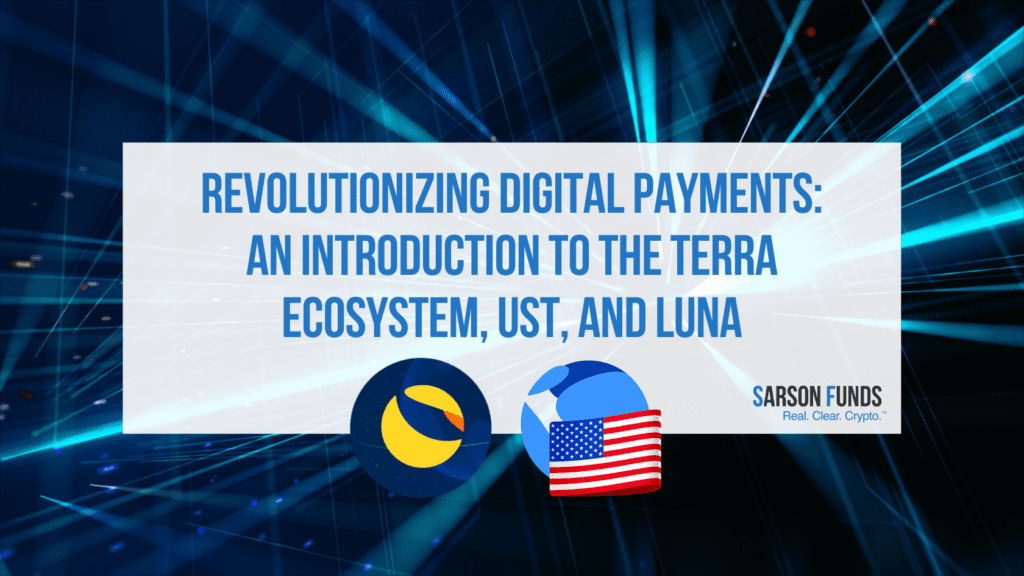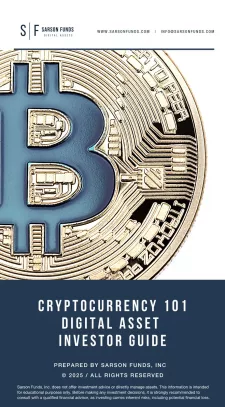
In this segment of Sarson Funds’ Defi Series for Financial Advisors, we will focus on the cryptocurrency and blockchain network, Terra. Terra’s explosive growth over 2021 and 2022 has positioned the network to lead the future of blockchain innovation and adoption. As blockchain utilities and yield generation opportunities develop, we believe financial advisors and professionals should be prepared to advise their clients on the most fruitful opportunities across chains with keen attention to the Terra ecosystem and the native token, LUNA.
Terra was founded in 2018 by computer programmers Do Kwon and Daniel Shin. With Terra, the founders sought to revolutionize digital asset payments. Terra is a decentralized, stablecoin-focused, smart contract blockchain that is known for its diverse array of decentralized applications (dApps) and problem-solving algorithms. In this article, we will discuss Terra’s approach to decentralized stablecoins, burning and minting, payment solutions, Terra-based dApps, along with some inefficiencies predicated in the network.
What is Terra?
Terra is a layer 1, proof-of-stake blockchain that hosts a network of stablecoins, dApps, and the native cryptocurrency LUNA.
Stablecoins are currencies that peg their value to an asset or government-issued currency. Oftentimes, stablecoins match their value to a specific country’s fiat money and attempt to maintain this price stability through a number of different algorithms or asset backings. Stablecoins are engineered to alleviate the volatility commonly associated with digital assets. Terra’s network of stablecoins, including UST, the Terra stablecoin algorithmically pegged to the U.S. dollar, offers cross-border value exchanges between tokens with negligibly small fees.
Terra’s cryptocurrency Luna enables on-chain governance and helps manage UST price stabilization. Luna and UST work together to ensure that at any point in time, one UST can be traded for one dollar’s worth of Luna, and vice versa.
Burning and Minting
Luna works to securitize the efficiency of Terra’s stablecoin network. The algorithms in the Terra blockchain manage this network security through minting and burning mechanisms. In crypto, minting means creating new tokens, while burning erases tokens. For every UST burned, one dollar’s worth of Luna is minted, and with every dollar’s worth of Luna burned, one UST is minted. This mechanism acts as a way for UST to stabilize its supply so that it can maintain its one-for-one peg to the dollar.
For example, if UST is above the price of a dollar, Luna holders are then incentivized to burn Luna and mint UST. The incentive to do this stems from the profit they can gain if Luna holders burn Luna and mint the equivalent amount of UST. Understanding efficient markets, once Luna is burned and UST is minted, the supply of UST is greater than its dollar equivalent of Luna’s price, pushing the price of UST back down to its pegged price point. The opposite process occurs with Luna if UST falls below a dollar. The mechanism behind this process introduces an interesting solution for stablecoin de-pegging as it balances supply with demand and allows for UST to maintain stability. Terra is notable for its unique mechanisms of maintaining balance, but it is also known for the solutions it brings to digital payments.
Payment Solutions
Terra has established itself as the cutting edge of digital payments, especially in the Asian e-commerce market.
The engineers of Terra constructed an advanced blockchain payment method that offers next-generation digital payment solutions. The Terra blockchain increases operational efficiency through comparably high transaction throughput, low fees, and competitive speed for users of the network, making scalable crypto payments more feasible than many of its competitors.
Terra’s payment solutions operate at a discounted rate compared to their competitors, with transaction fees ranging from .5 to 2%. The low fees in tandem with network scalability has prompted UST to achieve broad adoption, with MLB team of the Washington Nationals recently announcing UST’s future utility for Nationals products. The Nationals have a plan to accept UST as a payment method for fans at their home stadium as early as next season, while also renaming their notorious home plate club “The Terra Club.” The exciting rise of Terra’s network utility for everyday digital payments leaves us excited to see what other industries will implement similar deals with crypto platforms.
Terra’s Top Decentralized Applications
Out of the numerous decentralized applications that are offered on the Terra network, Terra World stands out as one of the most popular. Terra World is a metaverse where users can do business in a digital landscape. Users are able to buy virtual land and buildings in this metaverse while paying for virtual capital in the application’s native cryptocurrency, Terra World Token (TWD). All valuables in Terra World are tokenized as NFTs, including users’ avatars, which can be used to attend virtual business meetings, apply for jobs, and even create startups. Network engineers also plan on incentivizing users to be active in the world by airdropping top users’ TWD tokens. Terra World has created a platform for digital businesses to thrive, and has taken concrete steps toward a metaverse-based future.
Another Terra-based dApp is Anchor protocol. Anchor protocol is a decentralized savings platform that offers yields with low volatility and high APY. Anchor performs this through staking reward streams from some of the most prominent proof-of-stake blockchains around, including Ethereum. The protocol provides a stable APY of nearly 20%, savings yields that have been lost in traditional savings banks.
Orion Money is another yield optimizing dApp available on the Terra network. The application is an ecosystem service provider that helps cross-chain stablecoin holders in maximizing profitability from their yields, while also deflating risk and providing utility to unused assets. The dApp is essentially a multichain bank for stablecoins with functionality for payments, yield farming, and stablecoin savings.
Decentralized applications built on Terra have aided in the growth of the network, providing value and stability to network users. We are excited to see what future dApps will emerge in the ecosystem.
Centralization Risk
As with every blockchain, the threat of centralization is present in Terra. While malicious Terra centralization is not expected, it is something to remember when using every blockchain ecosystem. The network is still young, so nodes are being operated by a small number of validators compared to leading chains like Ethereum. As the ecosystem grows, we anticipate participation in network consensus will rise and diversify, alleviating some of this centralization risk.
Concluding Thoughts
Through the Sarson Funds DeFi series, we hope to help you understand the solutions blockchain technology and cryptocurrencies can bring to the everyday problems we face. Terra has established itself as a leading network providing a diverse array of utility for crypto users, from stablecoin payments, yields, and even metaverse integrations. Stay tuned for our next chapters of the Sarson Funds DeFi Series where we will continue to introduce blockchain utilities that reimagine the future of global systems.
By Colm McDonald
Disclosures: Not investment advice. It should be assumed that Sarson Funds or its affiliated managers hold positions in all projects that are discussed. It is not possible to invest in any project directly through Sarson Funds, Inc. or its affiliated managers. Any investment product offered by managers affiliated with Sarson Funds should be assumed to be only available to Accredited Investors and subject to the individual terms and conditions of that offering including but not limited to those eligibility requirements associated with U.S. Securities Regulation D, section 506c. Talk with your financial advisor before making any investment decisions or have them contact Sarson Funds directly at [email protected]








